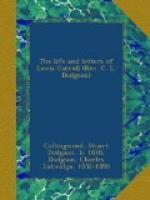It was a bold step to take, and elicited some loud expressions of disapproval. “Rather than buy on the terms Mr. Lewis Carroll offers,” “A Firm of London Booksellers” wrote in The Bookseller of August 4th, “the trade will do well to refuse to take copies of his books, new or old, so long as he adheres to the terms he has just announced to the trade for their delectation and delight.” On the other hand, an editorial, which appeared in the same number of The Bookseller, expressed warm approval of the innovation.
To avoid all possible misconceptions, the author fully explained his views in a little pamphlet on “The Profits of Authorship.” He showed that the bookseller makes as much profit out of every volume he sells (assuming the buyer to pay the full published price, which he did in those days more readily than he does to-day) as author and publisher together, whereas his share in the work is very small. He does not say much about the author’s part in the work—that it is a very heavy one goes without saying—but in considering the publisher’s share he says:—
The publisher contributes about as much as the bookseller in time and bodily labour, but in mental toil and trouble a great deal more. I speak with some personal knowledge of the matter, having myself, for some twenty years, inflicted on that most patient and painstaking firm, Messrs. Macmillan and Co., about as much wear and worry as ever publishers have lived through. The day when they undertake a book for me is a dies nefastus for them. From that day till the book is out—an interval of some two or three years on an average—there is no pause in “the pelting of the pitiless storm” of directions and questions on every conceivable detail. To say that every question gets a courteous and thoughtful reply—that they are still outside a lunatic asylum—and that they still regard me with some degree of charity—is to speak volumes in praise of their good temper and of their health, bodily and mental. I think the publisher’s claim on the profits is on the whole stronger than the booksellers.
“Rhyme? and Reason?” appeared at Christmas; the dedicatory verses, inscribed “To a dear child: in memory of golden summer hours and whispers of a summer sea,” were addressed to a little friend of the author’s, Miss Gertrude Chataway. One of the most popular poems in the book is “Hiawatha’s Photographing,” a delicious parody of Longfellow’s “Hiawatha.” “In an age of imitation,” says Lewis Carroll, in a note at the head, “I can claim no special merit for this slight attempt at doing what is known to be so easy.” It is not every one who has read this note who has observed that it is really in the same metre as the poem below it.
Another excellent parody, “Atalanta in Camden-Town,” exactly hit off the style of that poet who stands alone and unapproached among the poets of the day, and whom Mr. Dodgson used to call “the greatest living master of language.”




